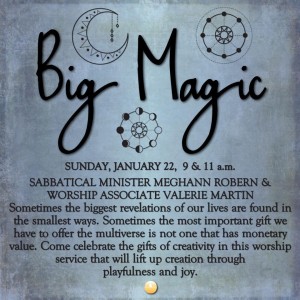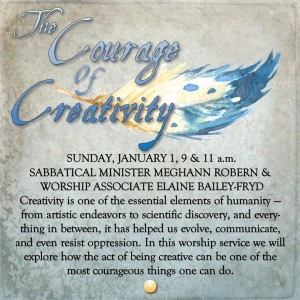Listen to the sermon here:
or watch and listen to the sermon on Facebook.
You may have figured out by now that my usual preaching style is to start with an opening — a story, a quote, a news story. Build it up into larger context, link it to one or more of our seven principles. Lift up the power of community to heal and restore, and then send you out with a call for living into our mission and values outside of this sanctuary.
Yes, I am that predictable.
Today, I am starting at the end. Because I believe we are at a crossroads in our human history, and I need you to hear this. If you take nothing else home with you today, please take this:
You have within you, right now, just as you are, everything you need to meet your muse, to engage with your genius, to raise your dead, to reclaim your creativity from where our culture told you to toss it in the gutter.
You have within in you the power to reconnect with that mysterious thing that calls to us from an early age. That force which led human beings to draw pictures on cave walls well before they developed agriculture. The need to create poured out of us thirty thousand years before we thought to cultivate reliable sources of food.
And creativity is not about making a product. That’s just something else to be sold. And, once again, our culture tells us that’s the only way creativity is valid — is if its value is about money.
The most important thing you can create is yourself, in relationship with the world around you.
Our reading today was an excerpt from Elizabeth Gilbert’s book Big Magic, in which she tells us her thoughts on why it is so important to extricate artistry and creativity from the concepts of suffering and torture. Valerie and I chose this story because it focuses on something a person, Susan does entirely for themselves. It’s not about winning medals, or performing in shows. There is no audience, no sponsorships, no livelihood waiting at the end of each ice skating session. This person has resurrected something from their childhood that gave them joy, that helped them live into their entire being.
And recognizing that as an adult — raising that feeling from the dead — and putting it back into her life, helped her become a better person overall. A better co-worker, a better friend, a better daughter. Putting it back in her life made her better, and that made her better to others.
Living into yourself, into your truth, can take so many different forms and expressions. Ruth chases her poems around her yard. Susan ice skates three times a week. I went back to school after ten years and became a minister. President George W. Bush became a painter. Every day, someone either learns something new about themselves, or rediscovers something left behind. Every day.
The question is, do we keep it, even if we have to chase it down and catch it by the tail, or do we allow it to slip through our fingers?
This brings me to our meditation, and confronting our fears. Fear of failure, fear of ineptitude, fear of putting time and effort into something that doesn’t bring us more stuff or money to buy more stuff. Fear of mediocrity, as if being average is a bad thing.
Well, if you were here on New Year’s Day, you know that I’m less than mediocre at running. I’m pretty bad at it. But in doing it, I’ve found something that goes deeper in me than running to win. And, if you were here on New Year’s Day, you also heard me attempt to make up a song verse and sing it with no rehearsal. Twice. To make the point I had to make up something totally different for the second service. We didn’t plan that to embarrass me, or anyone else who bravely came down to make up their own verses. We did it to lift up creativity as something that can, and often should be, fun and delightful and messy. That by sharing our experiments, and our bravery in taking these risks when we do so, there is nothing to fear.
And our meditation today reminds us that stories to embolden and inspire us to live into our own wonder and joy are not just coming from those around us, but from our own past. We can look not just to what we may have overlooked or tossed aside in our childhood, but also in our histories. Systems, especially family systems, carry long memories even when the details are forgotten. The homes in which we grow up, either by birth or by adoption, imprint their ghosts upon us. Sometimes they are malevolent, yes. But just as often, they are benevolent. They are our permission slip to chase the fullness of our being and co-create ourselves with the multiverse.
And, this is just when we’re working at the individual level.
There’s that saying that charity begins at home, which is often thrown around as an argument to be less charitable, actually. But in reality the original meaning of the phrase was about growth outward being a natural result of tending to the needs inward. That by starting with generosity in the home, one would naturally become more generous outside the home, because it would be an everyday practice well-integrated into one’s life.
So what I want to ask you today, is what would it feel like for you to be generous to yourself? What would it feel like to begin living into the affirmation of the inherent worth and dignity of every person, by affirm that about yourself?
So much of the fear we have around claiming our creativity is that we are taught to hate ourselves, and then to turn that self-hate out onto others around us who have less power. We witness it when the poor white worker, who is made that way by the policies of the rich, is convinced that their poverty is the fault of the black worker or the immigrant instead of the executive maintaining low wages and breaking unions. We are taught it when we are told that if something we love to do won’t pay us money, that we need to find an alternative to do with our lives, and we are a disappointment if we don’t succeed in filling our bank accounts.
Charity, generosity begins at home. What happens if we recognize that because we are worthy of health care, that has to mean everyone is, too? If creative expression is fundamental to our creation as humans — however you believe that creation to have come about — that has to mean that we should support learning how to empower it and express it in our homes and in our schools.
But most of all, in communities like this congregation, that exist to provide safe, loving, supportive environments for people to learn and grow — we have to support each other in being brave, in running toward the thing that inspires us instead of watching it disappear because we are afraid.
Fear is how we allow people to control and manipulate us. Fear is how we get convinced to back down when there’s a fight that needs to be had — a fight for our own sake as often s a fight for the sake of others. And when the fear becomes constant enough, when the anxiety is chronic, we become reactive, and apathetic. We dismiss it when people in power blatantly lie to our faces and get away with it. We insulate ourselves, and try to avoid drawing attention. We become collaborators with our own slow destruction instead of collaborating with our creative potential.
And nowhere was that creative potential more apparent than in the marches across the world yesterday. This was not an exercise put forward by “coastal elites”. It wasn’t even limited to big cities. Mentone, Alabama, population 360, had fifty people come together for their Women’s March. That’s 14% percent of the town’s entire population. In Alabama. Talk about creative expression. The smaller cities and towns, in the nation’s heartland, the turnout was just as astonishing, and this is where the oppression is the greatest, where their presence was needed the most.
In some of the bigger cities, so many people showed up that the entire route was filled from beginning to end, and they couldn’t actually march anywhere. So they shared food, shared stories. They played, and danced, and they sang.
But whether these gatherings had marching or not, they were an unstoppable outpouring of energy, just like those cave paintings on the wall from the infancy of our beginnings. They began from a single idea, tied to our country history of resistance to tyranny and oppression, and inextricable from thousands of years of patriarchy that has made white women second class citizens, and racism that has debased women of colour even more. The Women’s Marches were not only the largest protest in our nation’s history, they were a celebration of expression without fear. Of solidarity, and community, and of what it means to support each other in the diversity of our journeys into self-discovery and wonder.
They showed us what it looks, and sounds, and feels like to hold hands and stick together, like we’ve supposed to have been doing since kindergarten.
And so, I’ve come back around again to where I began. The most important thing you can create in this lifetime is yourself in relationship with the world around you. This is not a luxury. This is not a waste. This is not an irresponsible choice.
It is necessary. It is essential. It is vital.
Generosity begins at home, with you loving yourself so that you may pour that love out into others. Love yourself so that you can learn what the fullness of your being can be. Love yourself so that you are strong enough to learn from the wonder and joy of the diversity in our world, and not run away from it.
Love yourself, so that you may trust yourself, and chase your muse until you can grab it and hold it close.
May it be so.

